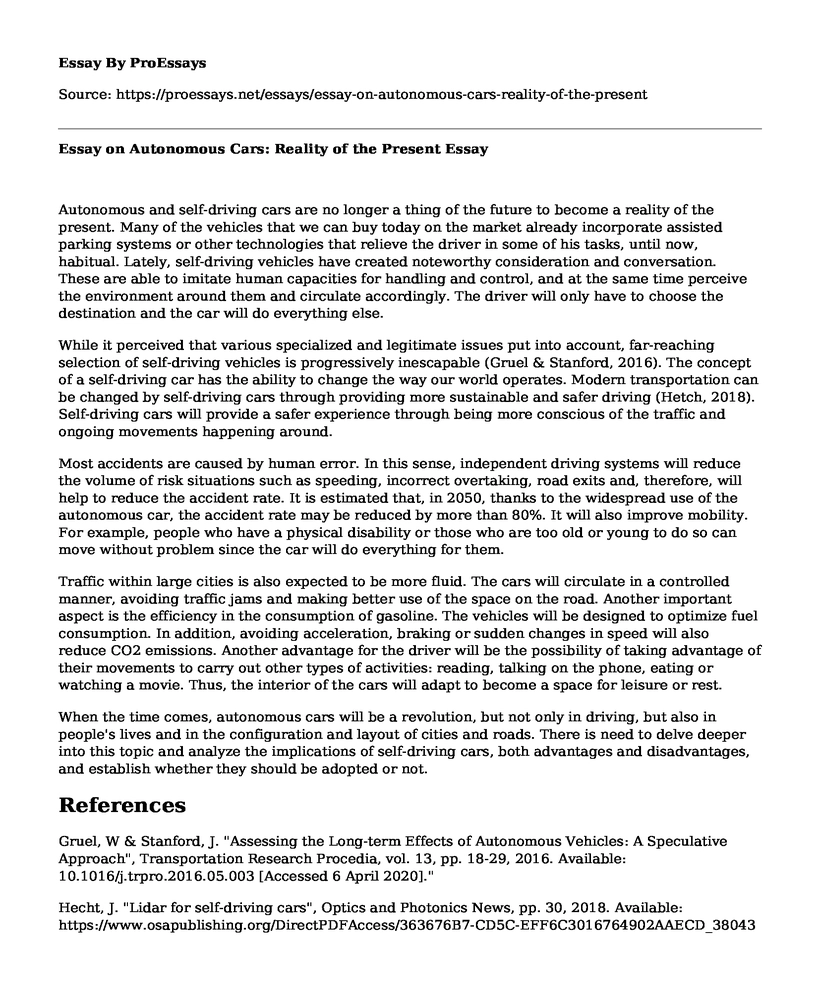Autonomous and self-driving cars are no longer a thing of the future to become a reality of the present. Many of the vehicles that we can buy today on the market already incorporate assisted parking systems or other technologies that relieve the driver in some of his tasks, until now, habitual. Lately, self-driving vehicles have created noteworthy consideration and conversation. These are able to imitate human capacities for handling and control, and at the same time perceive the environment around them and circulate accordingly. The driver will only have to choose the destination and the car will do everything else.
While it perceived that various specialized and legitimate issues put into account, far-reaching selection of self-driving vehicles is progressively inescapable (Gruel & Stanford, 2016). The concept of a self-driving car has the ability to change the way our world operates. Modern transportation can be changed by self-driving cars through providing more sustainable and safer driving (Hetch, 2018). Self-driving cars will provide a safer experience through being more conscious of the traffic and ongoing movements happening around.
Most accidents are caused by human error. In this sense, independent driving systems will reduce the volume of risk situations such as speeding, incorrect overtaking, road exits and, therefore, will help to reduce the accident rate. It is estimated that, in 2050, thanks to the widespread use of the autonomous car, the accident rate may be reduced by more than 80%. It will also improve mobility. For example, people who have a physical disability or those who are too old or young to do so can move without problem since the car will do everything for them.
Traffic within large cities is also expected to be more fluid. The cars will circulate in a controlled manner, avoiding traffic jams and making better use of the space on the road. Another important aspect is the efficiency in the consumption of gasoline. The vehicles will be designed to optimize fuel consumption. In addition, avoiding acceleration, braking or sudden changes in speed will also reduce CO2 emissions. Another advantage for the driver will be the possibility of taking advantage of their movements to carry out other types of activities: reading, talking on the phone, eating or watching a movie. Thus, the interior of the cars will adapt to become a space for leisure or rest.
When the time comes, autonomous cars will be a revolution, but not only in driving, but also in people's lives and in the configuration and layout of cities and roads. There is need to delve deeper into this topic and analyze the implications of self-driving cars, both advantages and disadvantages, and establish whether they should be adopted or not.
References
Gruel, W & Stanford, J. "Assessing the Long-term Effects of Autonomous Vehicles: A Speculative Approach", Transportation Research Procedia, vol. 13, pp. 18-29, 2016. Available: 10.1016/j.trpro.2016.05.003 [Accessed 6 April 2020]."
Hecht, J. "Lidar for self-driving cars", Optics and Photonics News, pp. 30, 2018. Available: https://www.osapublishing.org/DirectPDFAccess/363676B7-CD5C-EFF6C3016764902AAECD_380434/opn-29-1-26.pdf?da=1&id=380434&seq=0&mobile=no [Accessed 6 April 2020]."
Cite this page
Essay on Autonomous Cars: Reality of the Present. (2023, May 21). Retrieved from https://proessays.net/essays/essay-on-autonomous-cars-reality-of-the-present
If you are the original author of this essay and no longer wish to have it published on the ProEssays website, please click below to request its removal:
- Impact of Globalization on Emerging Markets - Essay Example
- User Interface Recommendations for a Multilingual Texting App
- Canada's Mobile Phone Market Paper Example
- Cyber Defense and Artificial Intelligence Paper Example
- Photoshop Media Innovation Essay
- Essay Sample on Digital Revolution: Impact of Technology on Teenagers Worldwide
- Essay Example on Wind Turbines: Safe Renewable Energy for Climate and Human Health







